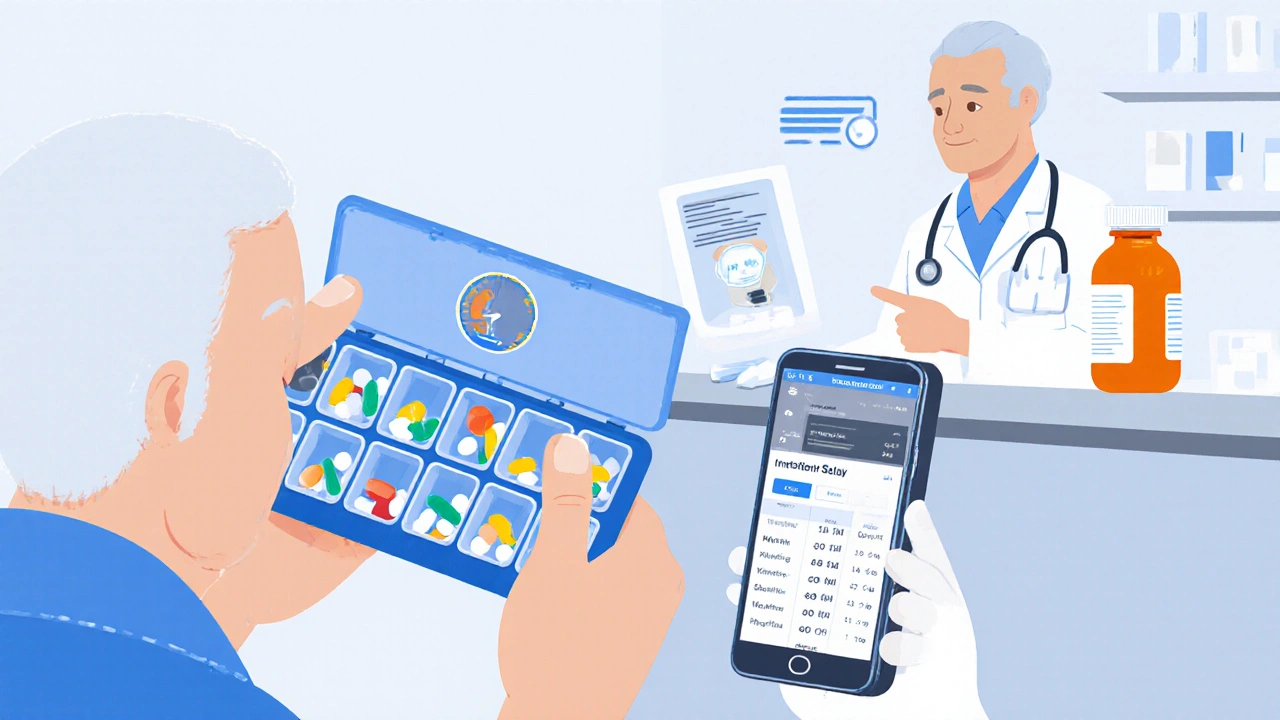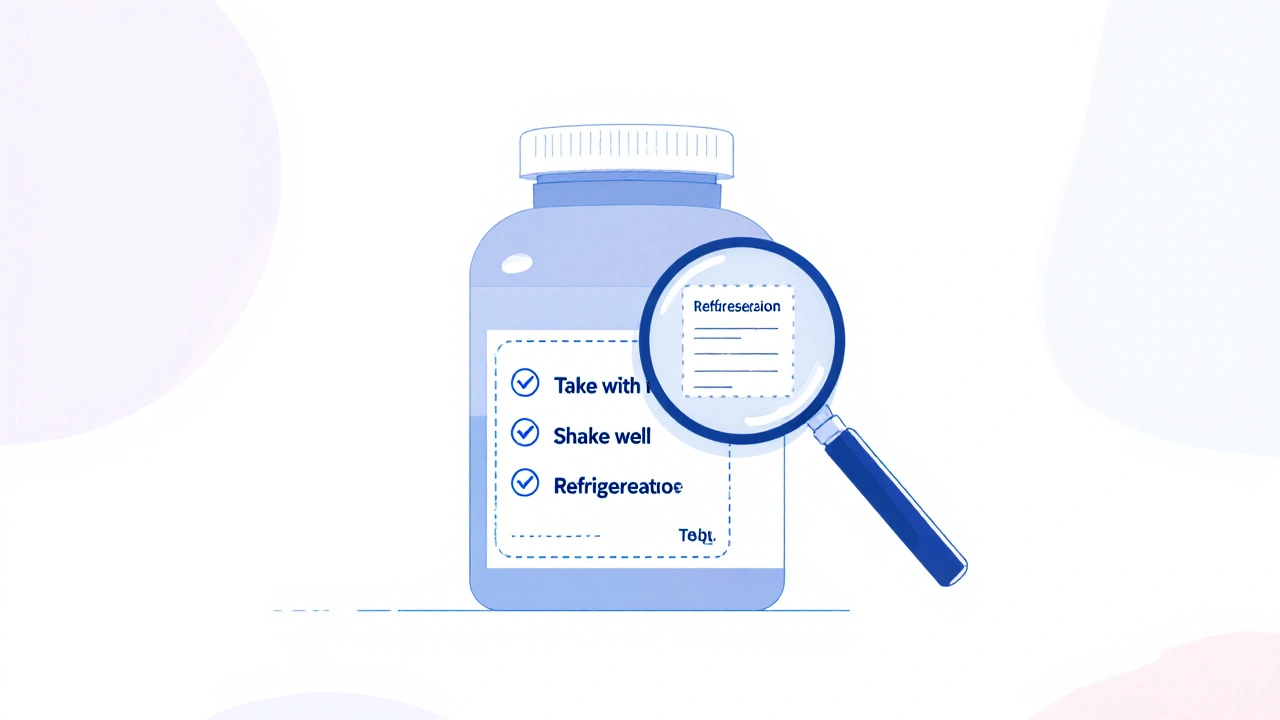Every time you pick up a prescription, there’s a small label stuck to the bottle. It looks simple-name, dose, date-but hidden in that tiny text are special instructions that could mean the difference between your medicine working as it should or causing serious harm. These aren’t just extra details. They’re safety rules written by pharmacists and approved by the FDA to keep you from making dangerous mistakes.
What Are Special Instructions, Really?
Special instructions on prescription labels go beyond "take one pill daily." They tell you how to take the medicine so it works right and doesn’t hurt you. Examples include:- "Take with food"
- "Avoid sunlight"
- "Shake well before use"
- "Refrigerate"
- "Do not crush"
- "Take on empty stomach"
- "Take one tablet every 12 hours"
- "Discard unused portion after 14 days"
These aren’t suggestions. They’re based on science. For instance, some antibiotics are absorbed poorly if taken with dairy. Others can cause severe sunburns if you’re exposed to UV light. Some pills break down if crushed, turning into a toxic mess. And if you don’t refrigerate a liquid antibiotic, it can grow bacteria.
A 2008 study found nearly half of all patients misunderstand these instructions. That’s not a small number-it’s 1 in 2 people. And when patients get it wrong, it leads to hospital visits, overdoses, or treatments that just don’t work.
Where Do You Even Find These Instructions?
You’d think they’d all be on the main label, right? Not always. According to the Cleveland Clinic, special instructions appear in three places:- 32% on the main bottle label
- 47% on a small sticker stuck on the bottle
- 21% in a separate paper insert
That means if you only look at the front of the bottle, you’re missing nearly half the critical info. A 2022 Consumer Reports survey found that 54% of people had trouble finding these instructions. One patient thought their blood thinner was safe to take with grapefruit juice-until they ended up in the ER. The warning was on a sticker they never noticed.
The FDA requires these instructions to be printed in at least 10-point font with high contrast so they’re readable. But in practice, many pharmacies still use small stickers with tiny text. If you can’t read it, ask for a large-print version. Ninety-four percent of U.S. pharmacies offer this for free.
Why "Take With Food" Is So Confusing
One of the most common-and most misunderstood-instructions is "take with food." It sounds simple. But what does "food" mean?A Harvard Health study found patients interpret it three different ways:
- 41% think it means "with the first bite of your meal"
- 33% believe it means "during the meal"
- 26% understand it as "within 30 minutes of eating"
That’s a huge gap. Some medicines need to be taken with a full meal to reduce stomach upset. Others need fat to be absorbed properly. Take a cholesterol drug like simvastatin with a light snack, and you might not get enough of it into your bloodstream. Take it on an empty stomach, and you could vomit.
Spanish-speaking patients are 3.2 times more likely to misinterpret "take with food" because direct translations don’t capture the nuance. The same issue happens with phrases like "on an empty stomach." Does that mean no coffee? No gum? No water? The answer varies by drug.

Timing Mistakes Are Deadly
"Take every 12 hours" sounds straightforward. But how many people actually space doses evenly? A 2022 study found 53% of patients take doses too close together-often because they forget and then double up later.That’s dangerous with painkillers, blood thinners, or seizure meds. One patient took her blood pressure pill at 8 a.m. and again at 9 p.m. thinking "every 12 hours" meant morning and night. She ended up with dangerously low blood pressure and passed out at work.
Doctors and pharmacists recommend setting phone alarms for timed doses. But even then, people often ignore them. A Mayo Clinic study showed pill organizers with time compartments reduce timing errors by 47%. They’re cheap, easy to use, and available at any pharmacy.
Who’s Most at Risk?
Not everyone struggles equally. About 36% of U.S. adults have basic or below-basic health literacy, meaning they have trouble reading and understanding medical info. For them, misinterpreting special instructions happens 62% of the time-more than double the rate of people with strong reading skills.Older adults are especially vulnerable. A 2022 JAMA study found that standardized instructions cut emergency room visits for seniors by 19%. That’s because older patients often take 5-10 medications daily. A single misstep can cause a chain reaction.
People with limited English face even bigger hurdles. A UCSF study showed non-English speakers misinterpret instructions at three times the rate of native speakers. Many pharmacies now offer multilingual labels, but you have to ask.
What You Can Do Right Now
You don’t have to guess. Here’s what to do every time you get a new prescription:- Check all three places: Look at the bottle, the sticker, and the paper insert. Don’t assume the main label has everything.
- Ask for clarification: Say: "Can you explain what ‘take with food’ means for this pill?" or "Does ‘every 12 hours’ mean exactly 12 hours apart?" Pharmacists are trained to explain this stuff.
- Use tools: Download a free medication reminder app (like Medisafe or MyTherapy). Use a pill organizer. Ask for large-print labels. These aren’t luxuries-they’re safety gear.
- Bring your list to every doctor visit: Write down every medication, including over-the-counter ones and supplements. Show it to your doctor. They might spot conflicts you didn’t know about.
One patient, a 72-year-old woman with diabetes, started using a pill organizer after misreading her insulin instructions. She hadn’t realized she was taking two doses too close together. After three months, her blood sugar stabilized. "I thought I was doing everything right," she said. "I just didn’t know I was doing it wrong."

The Bigger Picture
The U.S. spends $42 billion a year treating medication errors. That’s more than the entire budget of the CDC. The FDA is trying to fix this. By 2026, they plan to standardize 12 key instructions across all prescriptions-so "take with food" means the same thing everywhere.Some pharmacies are testing augmented reality labels. Point your phone at the bottle, and a video plays showing how to take the medicine. Others are using AI to customize labels based on your reading level.
But technology won’t fix everything. The real solution is education-and asking questions. You’re not being annoying if you ask, "What does this mean?" You’re being smart.
Pharmacists are your best resource. In fact, 89% of positive pharmacy reviews on Yelp mention staff who took time to explain instructions. Don’t be shy. Take five minutes. Ask. Write it down. Double-check. It’s not just about following rules-it’s about staying alive.
What Happens If You Ignore These Instructions?
Ignoring special instructions doesn’t just mean your medicine won’t work. It can cause real, dangerous side effects:- Not taking antibiotics with food? You could get severe nausea or diarrhea.
- Crushing a slow-release pill? You could overdose instantly.
- Forgetting to refrigerate insulin? It loses potency-your blood sugar spikes.
- Taking blood thinners with grapefruit? Your risk of internal bleeding skyrockets.
- Skipping doses or doubling up? You could trigger seizures, heart rhythm problems, or organ damage.
The Medicare Rights Center reported over 12,000 complaints in 2023 from beneficiaries who misunderstood labels. That led to $1.2 billion in preventable hospital stays. Most of those cases could’ve been avoided with one simple question.
What does "take with food" really mean?
"Take with food" means to take the medication during or right after eating. But what counts as "food" varies. For some drugs, you need a full meal with fat to help absorption. For others, even a small snack like crackers will do. Always ask your pharmacist: "What kind of food should I eat with this?" Don’t assume-it’s different for every medicine.
Can I split or crush my pills if they’re hard to swallow?
Never crush or split a pill unless the label or your pharmacist says it’s safe. Many pills are designed to release medicine slowly over time. Crushing them can cause a dangerous overdose. Extended-release opioids, blood pressure meds, and seizure drugs are especially risky. Ask for a liquid version instead if swallowing is hard.
Why do some prescriptions have extra paper inserts?
Those are Medication Guides, required by the FDA for drugs with serious risks-like blood thinners, antidepressants, or chemotherapy. They explain side effects, what to watch for, and when to call a doctor. Even if the label looks simple, always read the insert. It’s not optional-it’s life-saving.
I’m on multiple medications. How do I keep track of all the special instructions?
Use a pill organizer with time slots (morning, noon, evening, night). Pair it with a free medication app that sends reminders. Write down each drug’s instructions on a sticky note and stick it to your bathroom mirror. At every doctor visit, bring your complete list-including supplements and OTC drugs. Your pharmacist can check for dangerous interactions.
What if I don’t understand the instructions because English isn’t my first language?
You have the right to clear, understandable instructions. Ask the pharmacy for a translated label or an interpreter. Many pharmacies offer multilingual labeling, especially for common languages like Spanish, Mandarin, and Vietnamese. You can also request a video explanation-some pharmacies now offer QR codes that link to instructional videos in your language.
Can I just skip a dose if I feel fine?
No. Even if you feel fine, stopping or skipping doses can make your condition worse or cause withdrawal symptoms. Antibiotics, antidepressants, and blood pressure meds need consistent levels in your body. If you miss a dose, check the label or call your pharmacist. Never guess. A missed dose of insulin or seizure medication can be life-threatening.
Do I need to refrigerate all liquid medications?
Only if the label says so. Some liquid antibiotics, insulin, and eye drops require refrigeration to stay effective. Others can be stored at room temperature. If you’re unsure, ask your pharmacist. Leaving a refrigerated medicine out too long can make it useless-or dangerous. Always check the expiration date after opening.
Why do some labels say "discard after 14 days"?
Many liquid medications, especially antibiotics and eye drops, lose effectiveness after being opened. Bacteria can grow in them over time. Even if they look fine, they’re not safe after the expiration date on the label. Throwing them away isn’t wasteful-it’s necessary. Most pharmacies have medication disposal bins for safe drop-off.
Next Steps: What to Do Today
1. Check your current prescriptions. Look at every bottle. Find the sticker. Find the insert. Are you missing anything? 2. Call your pharmacy. Ask: "Can you walk me through the special instructions for my top three meds?" Don’t wait until you feel sick. 3. Set up reminders. Use your phone, a pill organizer, or a sticky note. Don’t rely on memory. 4. Ask for help. If you’re confused, you’re not alone. One in two people are. But you can fix it-right now.Medication labels aren’t meant to be puzzles. They’re meant to protect you. You don’t need a medical degree to understand them-you just need to ask.



Cinkoon Marketing
November 21, 2025 AT 14:33So many people just glance at the label and think they got it. I once took my antibiotic with a cup of coffee because I thought 'with food' meant 'not on an empty stomach'-turns out coffee doesn't count. My stomach hated me for a week. Always ask. Always double-check. Pharmacists aren't just there to hand you the bottle.
Also, if you're on more than three meds, get a pill organizer. It's not fancy, it's not expensive, but it's the only thing keeping me alive right now.
robert cardy solano
November 21, 2025 AT 22:26That sticker on the bottle? I used to ignore it. Thought it was just marketing fluff. Then my uncle ended up in the ER because he crushed his blood pressure pill. Turns out it was extended-release. One pill = whole day's dose. Crushed it = instant overdose. He's fine now, but scared the hell out of everyone.
Just read the damn sticker. Even if it's tiny. Even if you're in a rush. Your life isn't a suggestion.
Lemmy Coco
November 23, 2025 AT 09:50im not even kidding i once forgot to refrigerate my insulin because i was tired and just threw it in the cupboard. it was like 3 days. i didnt feel any different so i kept using it. then my blood sugar went crazy and i had to go to urgent care. the pharmacist looked at me like i’d just admitted to stealing a car. turns out the label said ‘discard after 28 days’ but only if refrigerated. i thought it meant ‘discard if you dont use it in 28 days’
lesson learned. now i have a little fridge in my bathroom. no joke.
rob lafata
November 23, 2025 AT 20:05Oh wow. Another ‘people are dumb’ article. Let me guess-you’re gonna say we should all be reading tiny print on stickers like some kind of pharmaceutical detective? Newsflash: the system is designed to confuse people. Big Pharma doesn’t want you understanding your meds. They want you dependent. They want you confused. They want you coming back for more.
And don’t get me started on ‘take with food.’ What food? A protein bar? A handful of almonds? A slice of bread? The label doesn’t say. Why? Because they don’t care. They just want you to take it. Period.
And yes, I know the FDA says ‘standardize.’ But standardization is a PR stunt. Real change? That’s when pharmacies start handing out laminated cards with simple icons. Not more words. Not more tiny print. Icons. Pictures. Something even a 70-year-old with shaky hands can get.
Matthew McCraney
November 24, 2025 AT 21:40They're watching us. Every time you take a pill, they're tracking it. The FDA, the pharmacies, the big pharma bots-they all know when you skip doses, when you crush pills, when you forget to refrigerate. That data? Sold to insurers. Used to raise your premiums. Used to deny you coverage later.
And the 'multilingual labels'? That's just for show. They don't translate the real warnings. The ones about liver damage, seizures, suicidal ideation. Those stay in English. Because if you don't speak English, you're not worth protecting.
I read the insert. I know what they're hiding. You think this is about safety? No. It's about liability. They cover their asses, not yours.
And don't even get me started on QR codes. That's how they get your phone data. Scan it. Track you. Sell you more pills.
You think you're safe? You're a lab rat with a pill organizer.
serge jane
November 24, 2025 AT 23:02There's something deeply human about how we treat medication labels. We treat them like instructions for assembling IKEA furniture-quick scan, hope for the best, curse when it doesn't work. But medicine isn't furniture. It's chemistry that lives inside us. It doesn't care about our assumptions.
When we say 'take with food' we're not just talking about digestion. We're talking about trust. Trust that the system will make it clear. Trust that someone cared enough to write it in a way we could understand. But we don't live in that world. We live in a world where time is money and labels are afterthoughts.
Maybe the real problem isn't that people don't read. Maybe it's that we've been taught not to expect clarity. That we've been conditioned to accept ambiguity as normal. And that’s the real tragedy. Not the missed dose. The resignation.
Asking 'what does this mean?' isn't weakness. It's the only act of resistance left against a system that treats our bodies like disposable machines.
Nick Naylor
November 25, 2025 AT 14:17And don't get me started on 'multilingual labels.' If you can't speak English, you shouldn't be on prescription meds. That's not bigotry. That's basic safety. You want to live here? Learn the language. Or stay home.
Sarah Swiatek
November 26, 2025 AT 07:26Oh honey. I love that you mentioned the 72-year-old woman with diabetes. That’s the exact reason I started making laminated cheat sheets for my elderly neighbors. One side: meds. One side: what ‘take with food’ actually means for each one. I drew little pictures. A sandwich for simvastatin. A glass of milk for the antibiotic. A clock for the 12-hour doses.
And yes, I’m sarcastic about it. Because it’s absurd that we live in a country where you need a PhD to understand your own insulin. But I’m not here to rant. I’m here to fix it. I’ve helped 17 people so far. One guy was taking his blood thinner with grapefruit juice because his son told him it was ‘healthy.’ He didn’t even know grapefruit interacted with meds.
Pharmacists? They’re the unsung heroes. But they’re overworked. So we have to help each other. Write it down. Share it. Don’t assume. Don’t Google it. Ask. Even if you feel stupid. Even if you’re 80. Even if you’ve been taking this pill for 10 years.
You didn’t know you were doing it wrong? Good. Now you do. And that’s how you stay alive.